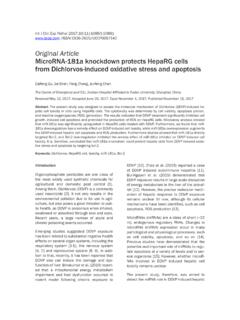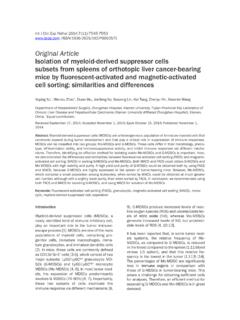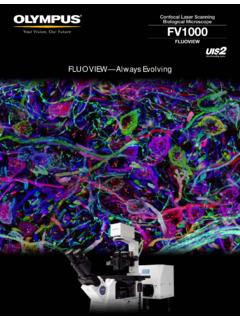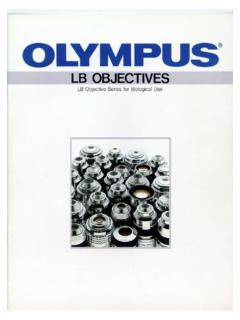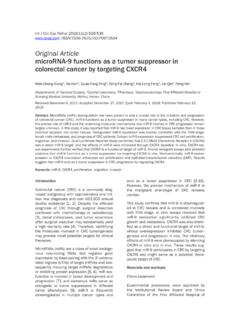Transcription of Original Article Complementary action of CXCL1 and CXCL8 ...
1 Int J Clin Exp Pathol 2018;11(2) /ISSN:1936-2625/IJCEP0069772 Original ArticleComplementary action of CXCL1 and CXCL8 in pathogenesis of gastric carcinomaXuyan Chen, Ruifang Jin, Renpin Chen, Zhiming HuangDepartment of Gastroenterology and Hepatology, The First Affiliated Hospital of Wenzhou Medical University, P. R. ChinaReceived November 24, 2017; Accepted December 17, 2017; Epub February 1, 2018; Published February 15, 2018 Abstract: Chemokine (C-X-C motif) ligand (CXCL) is a class of secreted growth factor that signals through a G-protein coupled receptor. CXCL protein family members play important roles in inflammation and aberrant expression is as-sociated with growth and progression of certain tumors. To explore the expression pattern and action mechanism of CXCL1 and CXCL8 in development of gastric carcinoma (GC), 72 cases of GC and para-carcinoma tissue speci-mens were used for experimental study, and qPCR was used for analysis on the expression of CXCL1 and CXCL8 in GC specimens.
2 For in vitro culture of GC cell HGC27, knockout of CXCL1 and CXCL8 genes for GC cell HGC27 was performed through RNA interference, proliferation of HGC27 cells was tested by MTT, apoptosis of HGC27 cells was tested by flow cytometry, and the influence of CXCL1 and CXCL8 on HGC27 cell migration was tested by transwell. CXCL1 and CXCL8 expression level in HGC27 cells was analyzed by Western blotting. Co-immunoprecipitation (co-IP) was used for identifying interaction of CXCL1 and CXCL8 with CXCR2 in GC cells. The results show that both CXCL1 and CXCL8 expression were significantly up-regulated. Relevant clinical data showed that low expression of CXCL1 and CXCL8 significantly correlated with features for poor prognosis of GC, including serum alpha-fetoprotein (AFP) level, tumor size, and TNM staging.
3 Down-regulation of CXCL1 and CXCL8 may up-regulate expression of each other and thus silencing expression of CXCL1 and CXCL8 may significantly inhibit proliferation and migration capabilities of HGC27 cells, and induce the apoptosis. Downregulated CXCL1 and CXCL8 expression in GC cells may significantly intensify interaction of one another and with CXCR2. The above results indicate that CXCL1 and CXCL8 participate in GC proliferation, apoptosis, and migration processes through specific binding with CXCR2 by a synergistic : CXCL1 , CXCL8 , gastric carcinoma, CXCR2, prognosisIntroductionGastric carcinoma (GC) is the fourth most com-mon malignant tumor worldwide. Although the incidence rate of GC greatly decreased globally in recent past decades, most GC patients have been diagnosed in middle or advanced stage, which was extremely unfavorable for treatment [1].
4 In recent years, molecularly targeted thera-py has gradually become a hot topic for research on cancer therapy. Growth, prolifera-tion, and metastasis of tumor cells are a sus-taining process, which need a continuous ener-gy supply, and angiogenesis provides a material basis for the process [2-4]. Chemokines control directional migration of cells [5] and if the expression and function of the chemokine and its receptor are abnormal, immunocytes will not be able to function properly at correct posi-tions [6]. The chemokines of CXCL1 and CXCL8 play an important role in pathogenic processes for several cancers [7, 8]. Relevant studies found that CXCL1 and CXCL8 could promote angiogenesis [9, 10]. Researchers using geneti-cally engineered mice have proven that angio-genesis has a promoting effect via CXCL1 .
5 Their studies showed that CXCL1 could induce angio-genesis through absorbing neutrophils and causing secretion of vascular endothelial gr- owth factors by neutrophils [11]. CXCL8 is a key factor for promoting growth and metastasis of GC, as well as angiogenesis [12]. Some studies showed that CXCL8 could adjust tumor cells and peripheral matrix cells into secreting matrix metalloproteinases MMP-2 and MMP-9, and which strengthens their activities. MMP-2 and MMP-9 could advance the activity of perivascu-lar collagenase, as well as the degradation of Role of CXCL1 and CXCL8 in gastric carcinoma1037 Int J Clin Exp Pathol 2018;11(2):1036-1045peripheral matrix, and promote the movement of endothelial cells to the direction of the angio-genesis factor along a degraded extracellular matrix, thereby promoting formation of tumor vessels [13].
6 However, signaling pathways upstream of CXCL1 and CXCL8 regulate expression. NF- B plays an important role in expression regulation and control of CXCL1 and CXCL8 . NF- B can be activated by Bcl-2 and the activated NF- B can up-regulate expression of CXCL1 and CXCL8 in vascular endothelial cells and induce migration and CXCL8 in 72 cases of GC tissues and ana-lyzed the correlation of CXCL1 or CXCL8 expres-sion with the pathogenesis of GC. Using RNA interference for knockout of CXCL1 and CXCL8 genes in GC cell HGC27 we also tested the influence of CXCL1 and CXCL8 gene knockout on proliferation, migration, and apoptosis. Materials and methodsTissue collectionFresh frozen GC and adjacent tissues were obtained from 72 patients who were diagnosed with GC and underwent radical gastrectomy at the department of Gastroenterology and Hepatology, The First Affiliated Hospital of Wenzhou Medical University from January 2009 to December 2011.
7 None of these patients underwent local or systemic therapy before surgery. This research was approved by the Research Ethics Committee of Wenzhou Medical University, China. And all patients signed the written informed consent. Quantitative real-time PCRT otal RNA was extracted and isolated from GC tissue samples using Trizol reagent (In- vitrogen, USA) following the user s manual. SYBR PremixExTaq (Takara, Japan) was used in Quantitative real-time PCR (qRT-PCR) on BIO-RAD MY IQ (USA). All primer sequences are shown in Table 1. The relative expression of CXCL1 and CXCL8 was shown as fold differ-ence relative to GAPDH. Cell culture conditions and transfectionThe human GC cell lines HGC27 were pur-chased from American Type Culture Collection (ATCC, USA), and the normal gastric mucosal epithelial cell line GES-1 was purchased from CICLR (Beijing, China).
8 Cells were cultured in (RPMI) 1640 medium supplemented with 10% fetal bovine serum, 100 U/ml penicillin and Table 1. Primer sequences of expression productsGene namePrimer namePrimer sequenceCXCL1 Forward primer5 CGCTACAGCGACGTGAAGAA3 Reverse primer5 GTTCCAGGCGTTGTACCAC3 CXCL8 Forward primer5 CTTTGTCCATTCCCACTTCTGA3 Reverse primer5 TCCCTAACGGTTGCCTTTGTAT3 GAPDHF orward primer5 ATGTCGTGGAGTCTACTGGC3 Reverse primer5 TGACCTTGCCCACAGCCTTG3 Figure 1. The relative expression levels of CXCL1 and CXCL8 in GC tissues. CXCL1 (A) and CXCL8 (B) were detected in 72 pairs of GC tissues with qRT-PCR. Data are presented as fold change in tumor tissues relative to normal tissues. NC, normal control tis-sues, GC, GC tissues. *P < of cancer cells [14]. The consistent effect of CXCL1 and CXCL8 in tumor vessel for-mation made us wonder whether there is a supplementary action between CXCL1 and CXCL8 in GC occurrence and devel-opment processes.
9 The mechanism for regulation of the growth of GC is still unknown. In this study, to clarify the action mechanism of CXCL1 and CXCL8 in the pathogenetic process of GC, we measured the expression level of CXCL1 Role of CXCL1 and CXCL8 in gastric carcinoma1038 Int J Clin Exp Pathol 2018;11(2):1036-1045 Table 2. Correlation of the expression of CXCL1 with clinicopathologic featuresClinicopathologic featuresn (%)Relative expression of CXCL1 PLowHighAge (year) < 5032 ( ) 5040 ( )2119 Sex Male39 ( ) Female33 ( )1320 Serum AFP level (ng/mL) < 2014 ( ) ** 2058 ( )4018 Tumor size (cm) < 526 ( ) * 546 ( )3511 TNM tumor stage I+II51 ( ) * III+IV21 ( )174 Compared with low CXCL1 expression group, *P < , **P < 3. Correlation of the expression of CXCL8 with clinicopathologic featuresClinicopathologic featuresn (%)Relative expression of CXCL8 PLowHighAge (year) < 5032 ( ) 5040 ( )2218 Sex Male39 ( ) Female33 ( )1815 Serum AFP level (ng/mL) < 2014 ( ) ** 2058 ( )4612 Tumor size (cm) < 526 ( ) ** 546 ( )397 TNM tumor stage I+II51 ( ) * III+IV21 ( )183 Compared with low CXCL8 expression group, *P < , **P < mg/ml streptomycin (Sigma, USA), at 37 C, in 5% CO2 incubator (Memmert, Ge- rmany).
10 The siRNA sequence of CXCL1 and CX- CL8 genes were designed by using Invitrogen (an online software), and the siRNA for CXCL1 and CXCL8 were purchased from Ribobio (Ribobio, China). The human GC cell lines HGC27 were transfected with siRNAs with flow cytometry software. All samples were test-ed three assaysHGC27 cells were resuspended 48 h after transfection, and then trypan blue staining was performed and the cell survival rate was deter-mined. If the rate exceeded 95%, then follow-Lipofectamine 2000 (In- vitrogen) following the user manual. Western Blot was used to verify the transfection proliferation assaysCell Proliferation Reagent Kit I was used to detect the proliferation of cells that were transfected by CXCL1 and CXCL8 siRNA.



